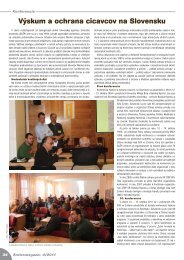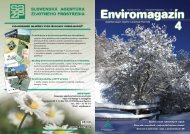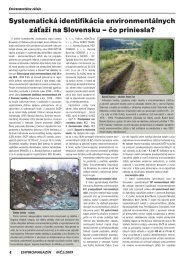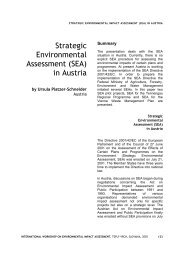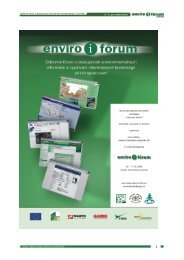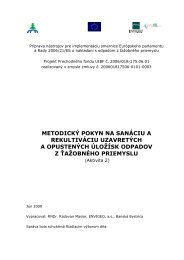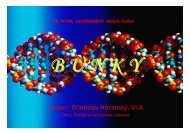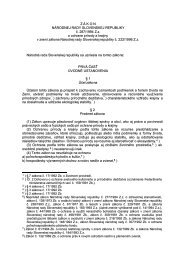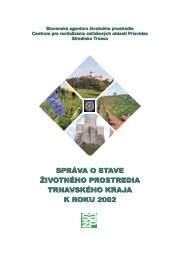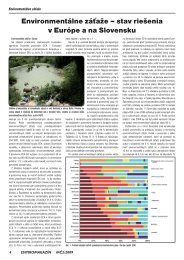Annex I - âDescription of Workâ - Hlandata
Annex I - âDescription of Workâ - Hlandata
Annex I - âDescription of Workâ - Hlandata
You also want an ePaper? Increase the reach of your titles
YUMPU automatically turns print PDFs into web optimized ePapers that Google loves.
CIP-ICT PSP-2009-3Pilot BHLANDATAValue-added application and result assessment:Demonstrating the value-added potential <strong>of</strong> the National Land Information System on land accountingapplication, integrated assessment service and integration with conventional statistical data will beconceptually based on developments in land cover accounts methodology as pioneered by theEuropean Environmental Agency. Based on the methodology <strong>of</strong> the integrated system <strong>of</strong> economicenvironmental accounting (SEEA2003) <strong>of</strong> the United Nations, land cover accounts are connected toother sets <strong>of</strong> tables which describe the use <strong>of</strong> the natural resources by the economy. The frameworkhas been developed to meet the needs <strong>of</strong> policy makers by showing how spatial indicators anddescriptive statistics can be used to monitor the interaction between the economy and the environment.Thus, land cover accounts will be used to serve as well as a platform to account for ecosystemintegrity and it will provide a set <strong>of</strong> tools that can be used in the context <strong>of</strong> natural capital valuation forsustainable development, strategic planning and policy analysis.An understanding <strong>of</strong> the implications <strong>of</strong> changes in land cover and land use is a fundamental part <strong>of</strong>planning for sustainable development. On the one hand the transformation <strong>of</strong> land cover and land useby human action can affect the integrity <strong>of</strong> natural resource systems and the output <strong>of</strong> ecosystem goodsand services. On the other, by careful planning, the development <strong>of</strong> new patterns <strong>of</strong> land cover and usecan enhance the well-being <strong>of</strong> people. The need to consider the coupling <strong>of</strong> social and ecologicalsystems through the study <strong>of</strong> land use change has been identified as an urgent priority by a number <strong>of</strong>organizations and need to develop and apply systems <strong>of</strong> economic-environmental accounting has beenwidely recognized by the international community.Land accounts, like those for other types <strong>of</strong> environmental assets, seek to describe how resource stockschange over time in a consistent and systematic way. By doing this, the implications <strong>of</strong> those changescan better be understood. The cover <strong>of</strong> land is not, however, simply an attribute or quality <strong>of</strong> land, buta concrete set <strong>of</strong> natural and anthropogenic features that largely results from its use. A given landcover can be modified, degraded or destroyed (consumed) and a new type generated. As such, theconsumption and formation <strong>of</strong> land cover is very similar to the transformation <strong>of</strong> capital goods in theeconomy. Since land cannot, in general terms, be created or destroyed land cover change can generallybe characterized in terms <strong>of</strong> different types <strong>of</strong> flows between land cover types. A key focus <strong>of</strong> landcover accounts is, then, the understanding <strong>of</strong> the way in which the stocks <strong>of</strong> different land covers anduses are transformed over time. Proposed LEAC framework features the following capabilities:• Stock and flows land accounts.• Spatial insight into consumption & formation and intensity <strong>of</strong> processes (dynamics).• Understanding <strong>of</strong> context (neighbourhood) <strong>of</strong> stocks and flows.• Framework for integration <strong>of</strong> socio-economic data.• Framework for spatial indicator development, statistic desegregations and modelling.Sub-Pilot 2.2: Establishment <strong>of</strong> a national land statistical accounting system based onGMES core mapping service productsPartner: AGI, CEITData provided from: LithuaniaStatistical land accounting system (SLAS) basically is used to keep the record <strong>of</strong> the amounts <strong>of</strong> differentland assets (arable land, forests, built-up areas, etc.) <strong>of</strong> the country and is essential in planning <strong>of</strong> budgetassignments and incomes, agricultural quotas as well as spatial planning on national and municipal levels.The current SLAS <strong>of</strong> Lithuania still follows practices inherited from the former Soviet statistical system,which was based on land asset estimates provided by <strong>of</strong>ficials in administrative units <strong>of</strong> the country, i.e. it'sdone on paper and provides numbers <strong>of</strong> “best judgment”, <strong>of</strong>ten seriously biased due to various reasons. Infact, similar practices are still in use at various extent all over the former “Soviet block” countries, nowmembers <strong>of</strong> EU.Since joining the EU in 2004, the entire domain <strong>of</strong> land management has changed dramatically in Lithuaniadue to implementation <strong>of</strong> EU regulations related to agricultural production planning and accounting,23/03/10 v11 16



